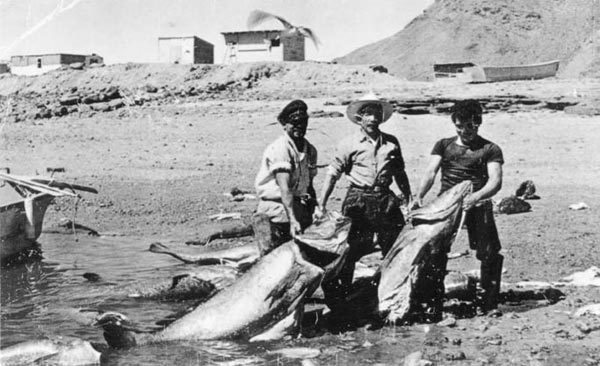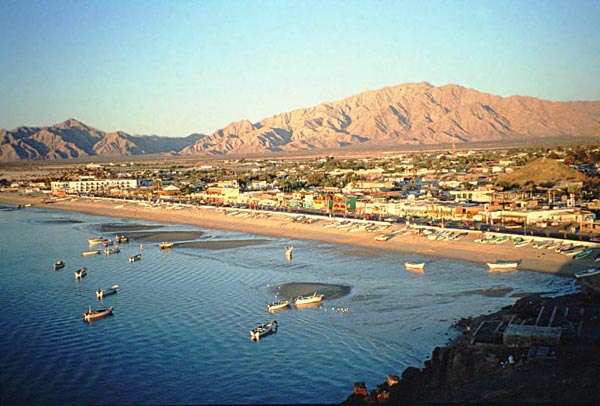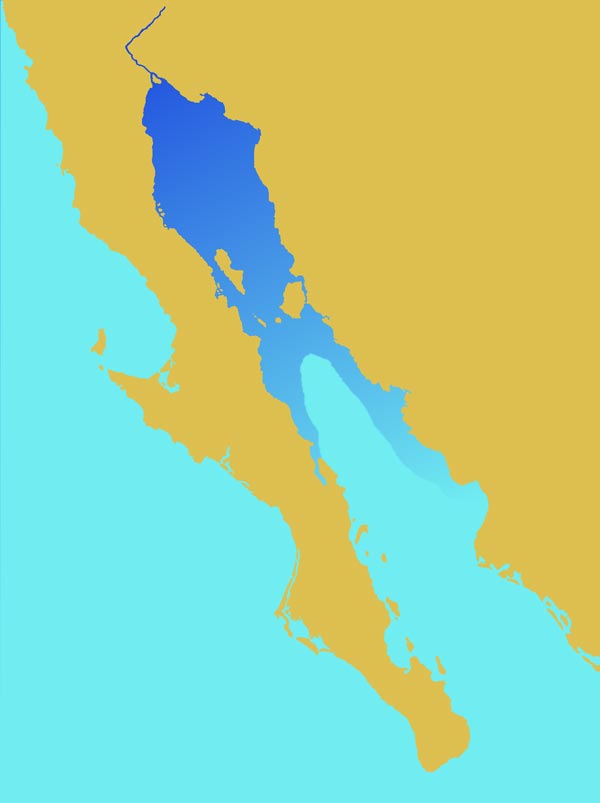
History of the Totoaba:
Mexico's Gigantic, Marlin-Sized Croaker
![]()
|
A commercial catch of enormous totoaba at Bahia San Luis Gonzaga, Baja California, Mexico. From left to right, Tony Reyes, Gorgonio Fernandez, and his son, Chi Chi Fernandez, c. 1954. --Reprinted with permission from The Unforgettable Sea Of Cortez. |
THE NEAR-EXTINCTION OF THE SPECIES CAME WITH STUNNING RAPIDITY
By Gene Kira, Western Outdoor News:
The dramatic story of the totoaba--Mexico's little-known giant croaker--is a lesson in how quickly and easily an enormous fish population can be wiped out.
I first learned of the totoaba when it's pure white fillets were sold as "totuava," a common English spelling, in neat, plastic-wrapped packages on Southern California supermarket shelves in the early 1960s--and then mysteriously and quietly disappeared again after only a few seasons.
At that time, I was unaware of the fantastic fish slaughter going on only 150 miles away, at the extreme north end of Mexico's Sea of Cortez. I was also unaware that the swift disappearance of those plastic-wrapped packages was merely the final act of a fascinating tale that had its origins in the very early years of the past century.
My introduction to the history of the totoaba and the people who fished for it began one fine spring day, some 20 years later, during a pleasant but unproductive morning of fishing on the Sea of Cortez, at San Felipe, about 50 miles from the mouth of the Colorado River.
As you look out over the calm waters of San Felipe today, it's hard to imagine that as recently as the 1950s these beautiful beaches were the scene of one of the most dramatic lessons mankind has ever learned about how fragile the life of the sea really is.
|
|
Ramon, my Mexican "panguero" fishing guide at San Felipe, was an old man--well over eighty--and no longer able to pull the starter rope of his outboard motor. But no matter, the fishing had been deadly slow all morning anyway.
As we floated together on a glassy-calm sea, three miles off the barren desert Mexican coast, I reeled in my line and set my rod down on the worn wooden seat of his skiff.
Ramon continued to tend his baited hand line, staring silently down into the water, occasionally pulling in an eight-inch croaker or small corvina, which he would toss into a plastic laundry basket.
"Not many fish at San Felipe today," I ventured.
"Very few."
As he continued to add small fish to a growing pile that I knew was intended for the table of his great-grandchildren that night, Ramon began talking--with perhaps a bit of sadness and pride in his voice--of his early life in San Felipe and the truly magnificent Mexican fishery that was once the northern Sea of Cortez.
In particular, he began talking of that gigantic member of the croaker or drum family (Sciaenidae), the legendary totoaba, or totuava, Cynoscion macdonaldi, that grew to the size of marlin and once swam in these waters in schools so thick they could be harpooned from the beach, literally with ones eyes held closed.
Ramon's family was originally from a small fishing village near Guaymas on the Mexican mainland shore of the Sea of Cortez. In 1928, Ramon's father heard of the great totoaba harvest that had been going on for several years near the mouth of the Colorado River--at the extreme northern tip of the gulf--and especially near the very small fish camp of San Felipe, which at that time consisted of perhaps half-a-dozen families.
The harvest of totoaba near Ramon's village in the Guaymas area had begun shortly after the turn of the century and had already reduced the local population to the point that the fishermen there were looking for another source.
Ramon, his mother, and his brothers and sisters walked around the north end of the Sea of Cortez to San Felipe--a trip of about 500 miles along a blistering-hot desert shore--while his father paddled their few possessions in a dugout canoe just off the beach.
Reaching San Felipe, they made camp on the white sand of what is now the downtown area of a growing city of 25,000 people, and Ramon and his father threw baited hand lines out from shore to catch many tons of the giant croakers that came to spawn in the extreme northern Cortez from late February to early June.
Business was good, and the fish were enormous, averaging about 100 pounds, with many larger ones over 200 pounds, and a few approaching and even thought to have exceeded 300 pounds.
(In 1961, California Fish & Game biologist, John Fitch, was quoted as having witnessed the weighing of a 330-pound specimen at San Felipe. In 1954, Western Outdoor News, the Southern California outdoor weekly, published a photo of a fish described as weighing 312 pounds.)
But the profit was not in selling the delicious white meat, which is almost indistinguishable from that of the white seabass, Cynoscion nobilis.
Instead, Ramon and his father cut out the fishes' yard-long buche (boo'-chee) or air bladders, dried them in the sun until they were hard as cardboard, and tied them into large bales which they sold to the buyer for as much as $5 U.S. per pound--a fortune for the time.
(The proper Spanish term for the air bladder is actually vejiga natatoria. The word buche more properly means the stomach or maw of the fish. However, "buche" is also used locally to refer to the air bladder, which was the part dried and sold.)
The dried buche were loaded 3,000 pounds at a time into pangas (open skiffs) and ferried back to Guaymas--the first leg of a journey that would take them to San Francisco, and ultimately to China, where they would be used in the preparation of an exotic, gelatinous soup stock called Seen Kow. This trade route had been opened up about 1915 after a few bladders were sent to China and found to be an excellent substitute for the local product traditionally used.
In the beginning years of the San Felipe totoaba trade--before Ramon and his family arrived in 1928--there was simply no market for the huge, six-foot-long carcasses left over after the buche had been cut out, so the fish were left in haystack-sized piles to rot in the sun. When the smell and flies became intolerable, the fishermen and their families would simply move down the beach and set up a new camp.
|
Modern San Felipe, Mexico. Giant totoaba were once caught from the beach here with handlines. |
Sometime in the early 1920s, a few American sport anglers had begun testing the waters around San Felipe, and in 1923, the first recorded totoaba--two fish--were exported to the United States. Word got out about the enormous piles of wasted fish. Soon thereafter, buyers from the United States reached San Felipe in ice trucks specially equipped to make the 125-mile open desert crossing from the U.S. border at Calexico.
In the winter of 1924-25, 170,000 pounds of fish were hauled north to the Southern California market. The totoaba were bought on the beach for as little as five cents per fish, and sold at a tremendous profit.
A brisk trade developed overnight. Within a year, a rough dirt road was constructed to the now rapidly-growing village of San Felipe. By 1927-28, the year Ramon's family arrived at San Felipe, over 1.8 million pounds of totoaba reached the Southern California market. The harvest peaked in 1942 with over 4.9 million pounds taken, according to some records. (Other records indicate the peak came in 1946 with 2.8 million pounds. Although the fishing continued through World War II, government statistics are not available during that period.)
During this period, the dried buche of the totoaba were also sold to the large Chinese population of Mexicali, who had arrived as immigrant field laborers during the 1930s and had become an integral part of the booming border town.
During the 1940s, the catch gradually become much more difficult, due to heavy overfishing and the damming of the Colorado River in 1935, which gradually cut off the flow of brackish water necessary for spawning and survival of young. In those years, Ramon and his father no longer caught totoaba from the beach. Instead, they fished from their small canoe, then from a panga with an outboard motor, and finally, they gave up entirely.
After World War II, the catch of totoaba and the closely-related but much smaller white seabass, corvinas and croakers in the waters surrounding San Felipe also became seriously affected by an enormous fleet of shrimp trawlers which had, since about 1935, been following the hand-lining pangueros north from Guaymas. Long rows of these bottom-scrapers, working in a staggered formation, scoured the soft mud ocean floor from one side of the gulf to the other, destroying the food-producing habitat as they harvested their "pink gold" for an exploding world market.
The coup de grâce came about 1957, when for the first time dynamite was widely used and gill nets were strung across the totoaba's migratory pathways as they came up the Sea of Cortez and entered the mouth of the Colorado River.
Until that development, the totoaba had resisted fishing pressure fairly well because they did not feed appreciably as they swam northward to the spawning grounds. Thus, they had been relatively immune from commercial fishermen using baited hand lines--at least until after they had broadcast their eggs and milt. But once dynamite and gill nets were introduced, the heavily-laden, anadromous fish could be intercepted on their way to the mouth of the Colorado River--before spawning could take place--and the species was virtually wiped out within a few years. The vulnerability of the totoaba in this respect is similar to that of salmon and steelhead.
In the 1960s, a large and rapidly-growing sport fishing trade was nipped in the bud, as the totoaba catch slid steadily downwards and then plunged to practically nothing.
American sport fishing columnist, Ray Cannon, wrote in Western Outdoor News in 1965: "As a great commercial game fish, the giant, up to 300-pound totoaba seems close to losing its popularity, if not its very existence.
|
|
"The once enormous migrating schools have now been reduced to a scattered few, which because of their peculiar spawning habit, may now be too depleted to reproduce a sustaining number.
"This great croaker which once drew as many as 10,000 people for an Easter weekend to San Felipe, will cease to attract any visiting anglers unless drastic action is taken to halt gill netting..."
Mexican regulations for sport and commercial fishing varied from year to year, with a limit of one sport-caught totoaba per angler imposed about 1962. But the few fish caught with hook and line were just a tiny percentage of the number taken with nets and dynamite. By 1968, the sport fishing industry that had once attracted thousands to San Felipe, Puerto Peñasco and El Golfo de Santa Clara was all but dead.
In 1975, the Mexican government finally published Norma Official Mexicana NOM-ECOL-059-94, which granted the totoaba official protection.
In 1976, international trade of the air bladders, or buche, was banned by the Convention on International Trade in Endangered Species (CITES).
And, in 1978, totoaba were officially listed under the U.S. Endangered Species Act.
But by then, the once almost unlimited population of this amazing fish was nearly gone.
During the disastrous 1975 commercial season, only 116,000 pounds of totoaba were taken, despite massive netting, and the Mexican government subsequently removed the fish entirely from the permitted commercial and sport fishing catch lists. In 1993, an ecological reserve was established north of the line between San Felipe and Puerto Peñasco on the east side of the gulf, and the totoaba has been placed on the U.S. Fish & Wildlife Endangered Species List, along with the vaquita porpoise, Phocoena sinus, only a few examples of which remain.
Since protection was imposed, the totoaba has made a modest comeback. Fish to about 30 pounds are now seen fairly commonly, and a few are seen to about 70 pounds. However, the rebound has been held back by continued illegal commercial fishing, which is still widely practiced today. Although it is illegal to import totoaba into the United States--and officially there are heavy penalties for catching them in Mexico--good numbers are still taken each season because enforcement is spotty at best.
Ironically, the relatively small income possible through this covert commercial fishing for totoaba is but a fraction of what might be earned through tourism if the fish were allowed to regenerate themselves, as they appear capable of doing. Some 700 miles to the south, the exponential economic growth of Baja California's Los Cabos corridor is fueled more by sport fishing--primarily for marlin--than by any other single factor. The totoaba, if brought back even partially, might once again draw thousands of tourist anglers with a density of marlin-sized fish undreamed of in the open Pacific.
The old, faded photos are still there, hung on walls and tucked into albums, in the fishermen's homes at San Felipe and the other coastal towns of the northern Sea of Cortez. And the totoaba are still there, greatly reduced in numbers and size, but ready to return in those massive spring spawning runs, if only given a chance.
But those incredible schools of huge, marlin-sized croakers are just a memory. On the beautiful tourist beaches of today's San Felipe, very few people are aware of the phenomenal fishery that existed there only a short time ago.
TOTOABA NOTES:
The totoaba, Cynoscion macdonaldi, is the largest member of the family of fishes known as croakers or drums (Sciaenidae), because they are capable of making loud, frog-like croaking sounds by manipulating their air bladders.
The closest relatives of the totoaba include the white seabass, the orangemouth and shortfin corvinas, and the very similar seatrouts or weakfish of the East Coast.
The range of the totoaba is very limited, and the species is highly vulnerable because, for all practical purposes, the entire population spawns only in the mouth of the Colorado River. At times other than the spawning season (late February to early June), the fish reside in pockets of deep water in the Midriff Area, located about one-third of the way down the Sea of Cortez. Thus, virtually all totoaba spend their entire lives within a circle only about 300 miles in diameter. A few fish have been found as far south as Mulege, and there is at least one record of a possible winter spawning run into Bahia Concepcion, but those are exceptions.
Young totoaba remain in brackish water for a period, feeding on shrimp and small fish before migrating to the Midriff. Adult fish feed on crabs, anchovies, and other forage species, eventually graduating to larger prey. In the early days, the most effective baits for them were whole shrimp or ten-inch croaker. The larger fish have a medium strike and a fight characterized by stubborn endurance, examples of which have exceeded five hours in duration.
Totoaba grow faster than resident bass species, but slower than pelagic migrators. Nose-to-tailfork lengths average about 11 inches at one year old; 18 inches at two years; and 24 inches at three years. A four-foot-long fish is about eight years old. After that, growth slows down. In the early days, the largest fish caught were over 15 years old.
A FISH BY ANY OTHER NAME:
Nobody knows the etymology of the word "totoaba," which is putatively of native American origin and has many spellings. In Spanish, the letter "v" and the letter "b" have virtually the same pronunciation, which causes the most proper Spanish spelling, "totoaba," and a sometimes seen variant "totoava," to be pronounced the same way. The most common English spelling is "totuava," which may have been a corruption originally introduced by U.S. supermarkets in the 1960s, along with another variant, "totuaba," which may be seen as a corruption of "totuava," in itself a corruption of "totoaba." In current usage, the most common Spanish spelling, "totoaba," is increasingly accepted.
|
The range of the gigantic totoaba extends from the mouth of the Colorado River to the south end of the Midriff Area, Sea of Cortez, Mexico. They are found no place else in the world. These fish, which once grew to well over 200 pounds in weight, are making a modest comeback, but illegal fishing is again threatening to wipe them out. |
(Related Mexico articles and reports may be found at Mexfish.com's main Mexico information page. See weekly fishing news, photos, and reports from the major sportfishing vacation areas of Mexico including the Mexico area in "Mexico Fishing News.")
MEXICO FISHING INFO MEXICO FISHING INFO "WEEKLY MEXICO FISHING NEWS" FISH PHOTO GALLERY


